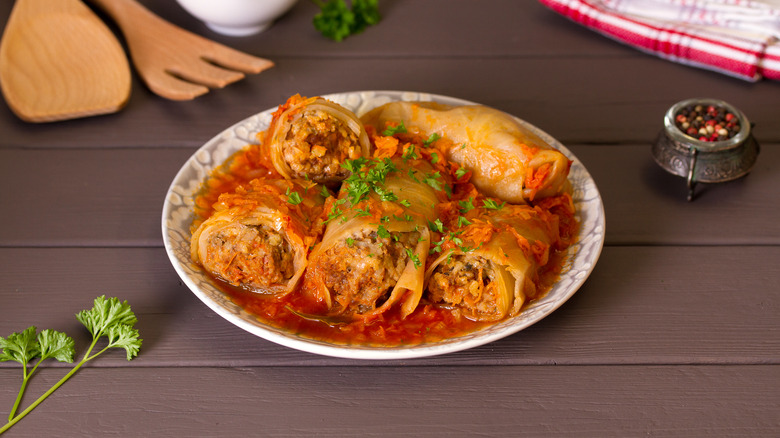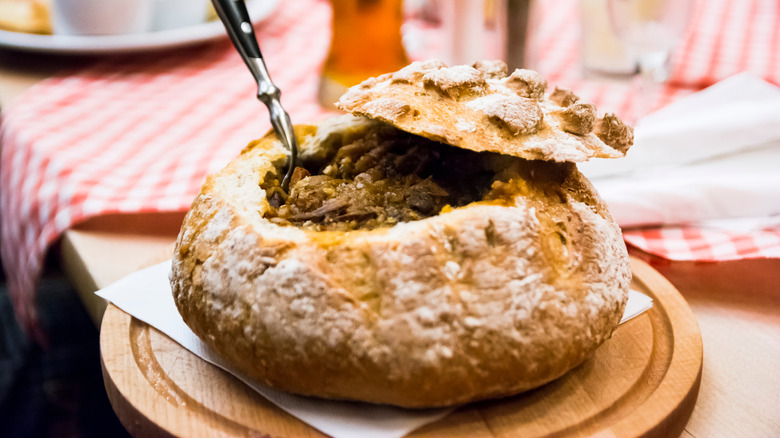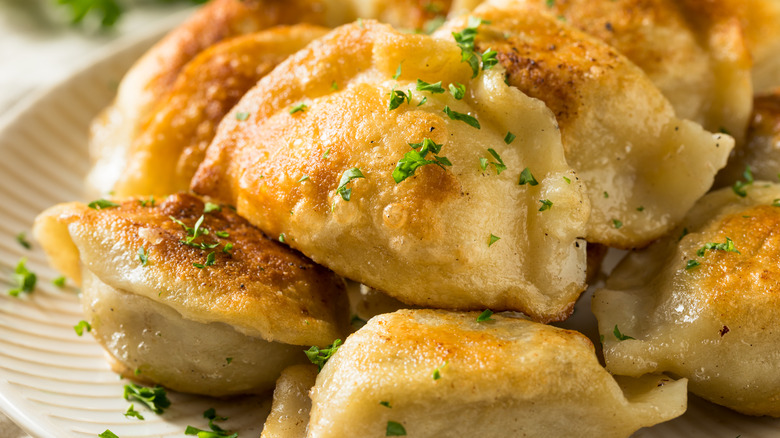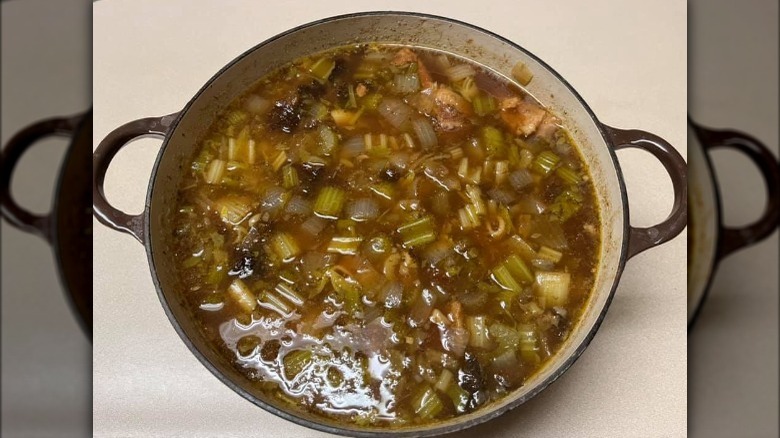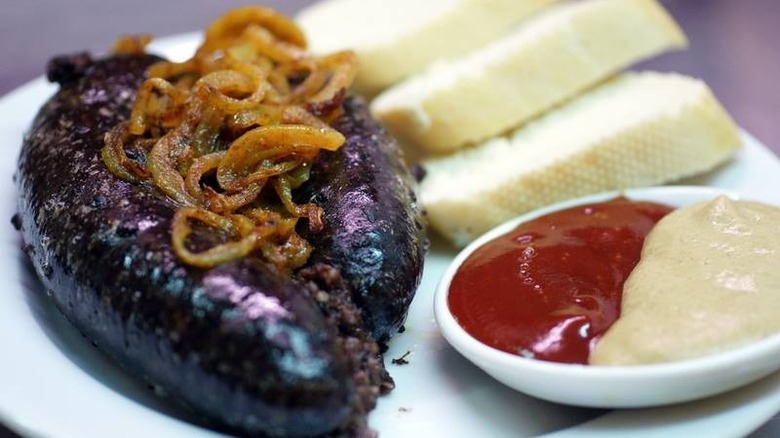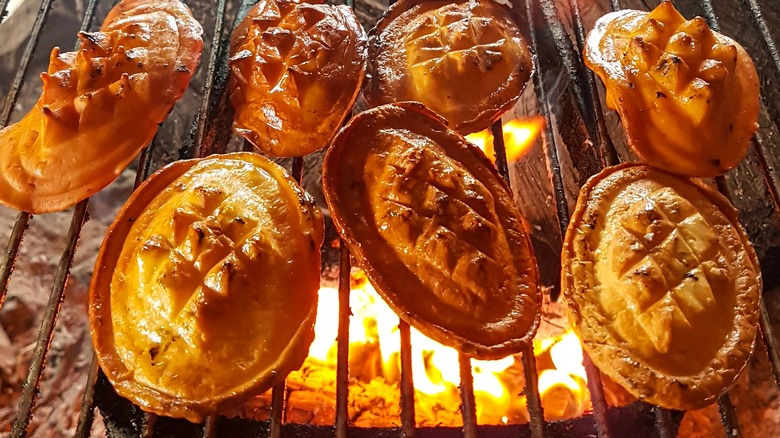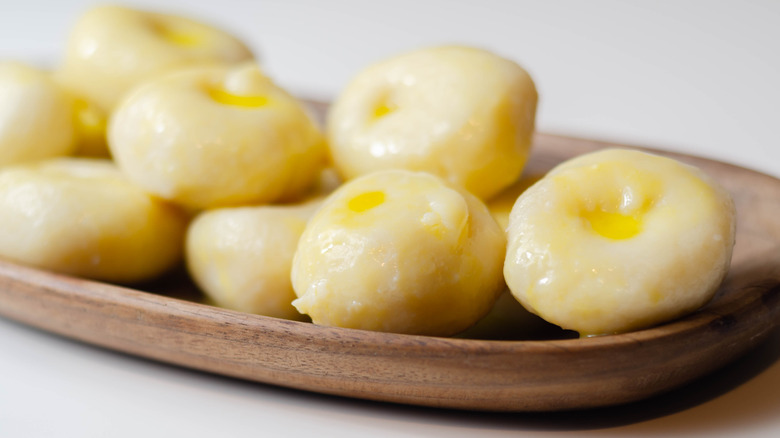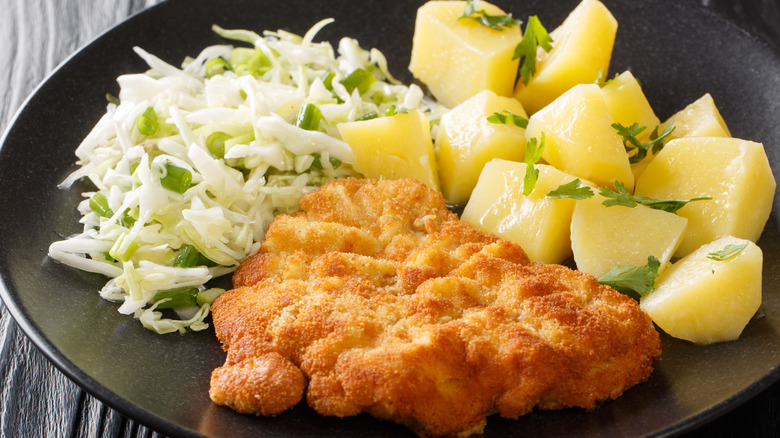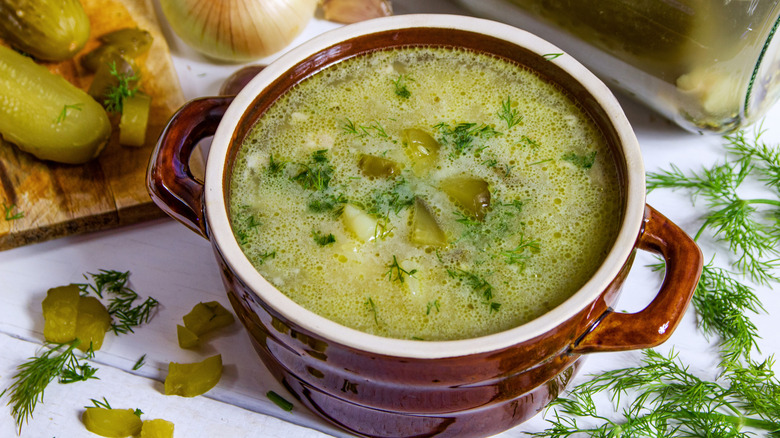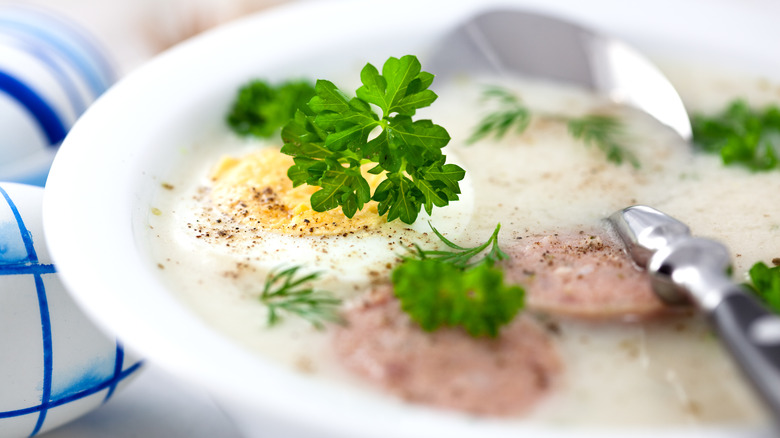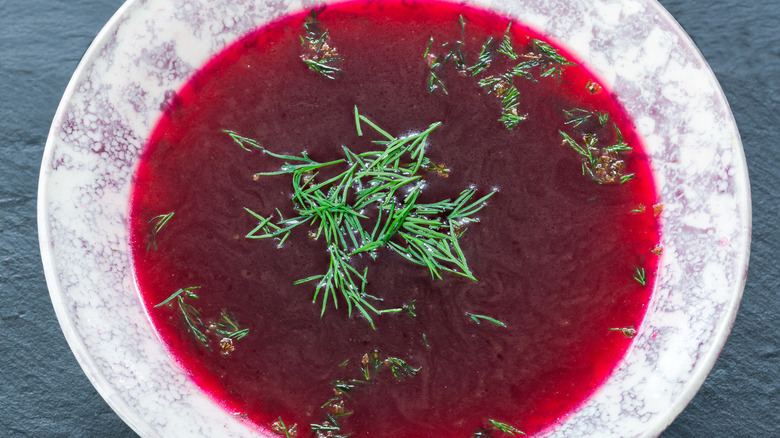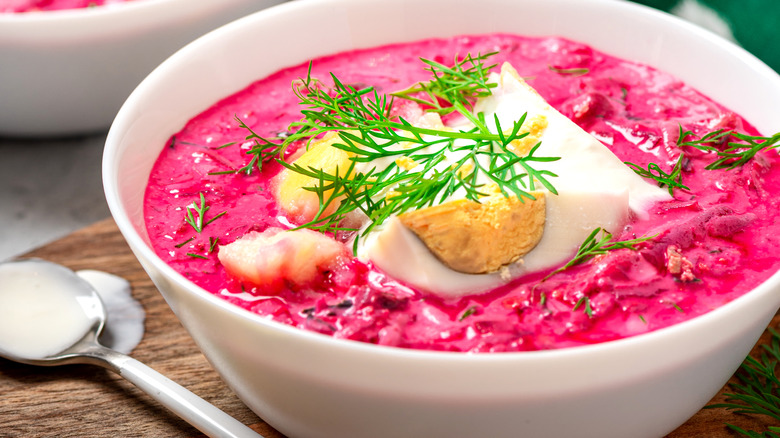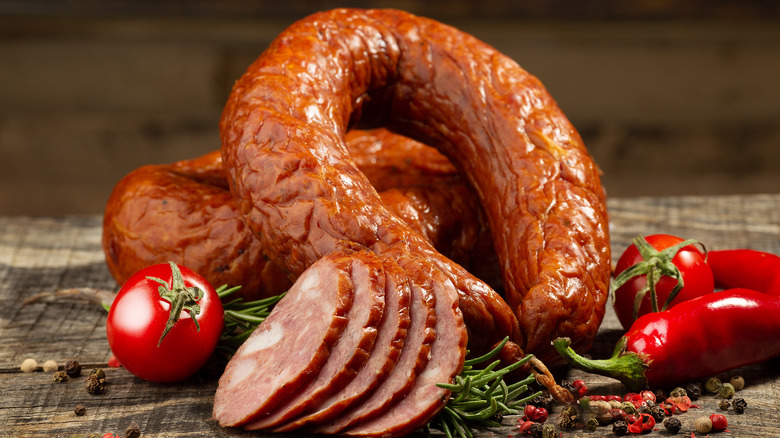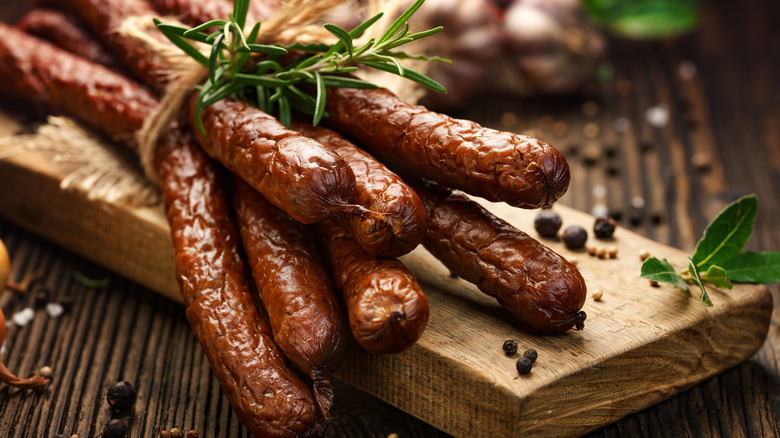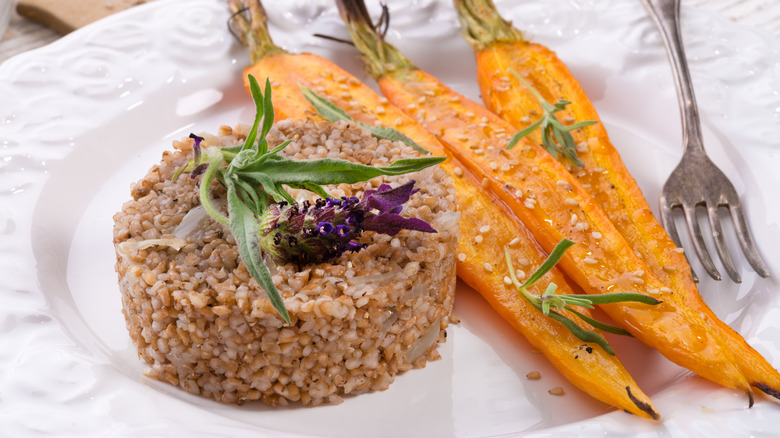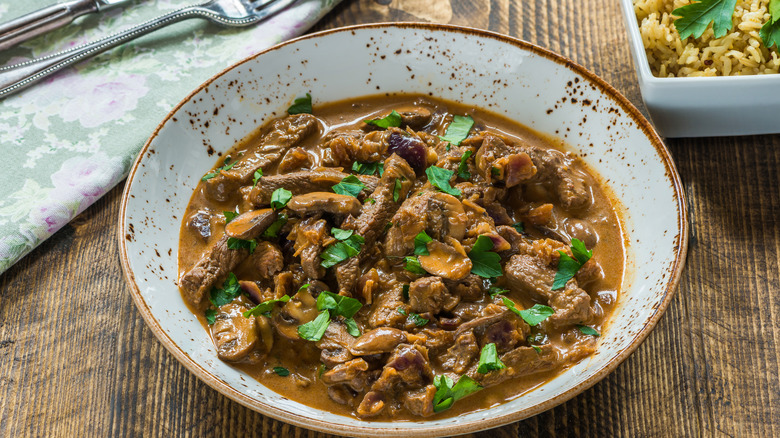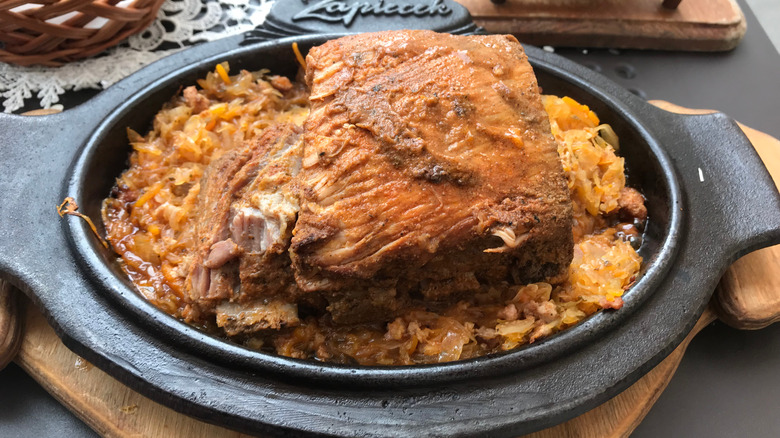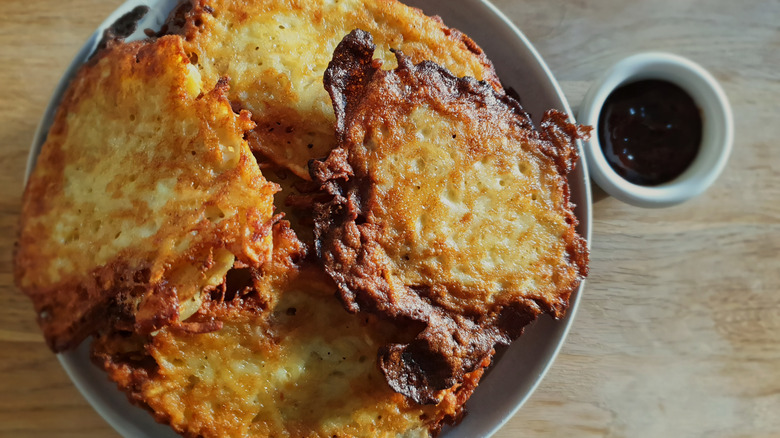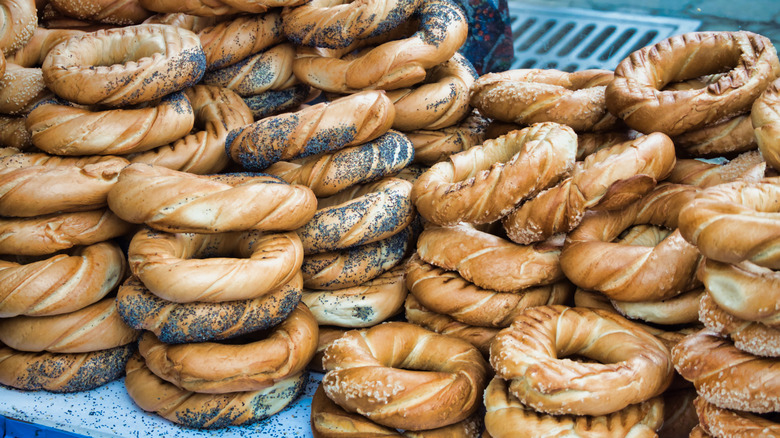25 Polish Foods You Need To Try
Sitting virtually at the center of Europe, the Republic of Poland (or just plain Poland) has a particularly fascinating history and culture, in part because its borders have changed so frequently over the course of history. In fact, Poland did not even exist as a nation between 1795 and 1918, when it was divided up among Russia, Austria-Hungary, and Prussia (via National Geographic). While Poland was restored as a sovereign nation in 1918, by 1939, it was once again invaded and occupied by Germany. History writes that just weeks after that, the Soviets laid claim to a full three-fifths of Poland's geographical area and 13 million of its people.
Although it regained its sovereignty in theory in 1945, Poland remained a Soviet Satellite until 1989. Notwithstanding, and perhaps even as a result of having lived under siege for so many years, the Polish people developed a strong sense of nationalism. Every Culture says that Polish cuisine is dominated by foods fit for a hard-working proletariat, with emphasis on meat, potatoes, cold-weather vegetables, and bread. Consistent as this is with American culture, it makes sense that there are so many foods of Polish origin that Americans are either fond of or very likely would be if they were given the opportunity to try them. Here are 25 fascinating and delicious Polish foods that we think you need to try.
1. Stuffed Cabbage Rolls
According to Every Culture, cabbage, along with beets, carrots, and potatoes, grows abundantly in Poland's cool weather, and for many Poles, "dinner is not dinner without meat." Add to that the fact that one of the cuisine's traditional flavor combinations is sweet and sour, and it quickly becomes clear why stuffed cabbage (or rolled cabbage, or simply golabki, as it is known in the Polish language) is such a popular and ubiquitous dish (via Polish Foodies).
Stuffed cabbage rolls are made from any kind of chopped meat, usually pork, mixed with rice, which is and always has been a great way to stretch a relatively small amount of meat into a meal for a family. The mixture is seasoned with garlic and paprika before being rolled in cooked cabbage leaves. They are served in a tomato-based sauce that features both sweet and sour notes. This recipe from Food.com uses a sprinkle of brown sugar and a spoonful of lemon juice to achieve that flavor combination.
2. Bigos (hunter's stew)
Bigos is a meat-based stew with sauerkraut, potatoes, bacon, and kielbasa (a Polish sausage we'll be discussing in a bit), according to Polish-born Marcin Tulinski. Bigos is also one of those dishes that mirrors Poland's cultural and geographical evolution. While bigos is so closely associated with Poland that it has been referred to at times and by various sources as Poland's "national dish" (via TasteAtlas), its inclusion of sauerkraut, which, like the rice in rolled cabbage, helps to stretch out a small amount of meat for a hungry family or another large group, would appear to have a German influence, according to cookbook author behind The Domestic Man, Russ Crandall.
"Polish cuisine prides itself in hearty and comforting dishes," notes TasteAtlas, which also points out that bigos has been part of "Polish culinary tradition since the 17th century." A number of Polish recipes suggest that bigos should be started at least two days before it is to be eaten so that it can be cooked once and then reheated twice more (via BBC Food), presumably to deepen the flavor. Tulinski agrees, adding that during the long cooking process, bigos is to be diluted with wine. Traditionally, one accompanies bigos with a shot of Polish vodka.
3. Pierogi
A "pierog," according to Marcin Tulinski, refers to a dumpling of Polish origins that can be filled with almost anything — whether meat, kashi, vegetables, cheese, or even sweets like fruit and chocolate. "Pierogi," Tulinksi clarifies, is the plural form, which is why you'll never see us putting an "s" at the end of the word. Apart from the spelling challenge that it offers to English speakers, Pierogi is "undoubtedly Poland's most famous and simple comfort food," according to CNN. "From street food spots to fancy restaurants, they can be found pretty much everywhere in Poland."
Although pierogi is a dish closely associated with Poland, it may have Russian roots as well — which makes sense when you consider the extended Soviet occupation of Poland (via MyRecipes). You may already be familiar with pierogi because it is not only very popular in Poland, but also in the U.S. If you're looking for an easy recipe for pierogi that you can make yourself, here's our "lazy pierogi" recipe.
4. Czernina
If you're getting serious about your relationship with a Polish woman, and either she or her family invites you to dinner, you'd better hope that the Polish soup czernina is not on the menu. Marcin Tulinksi states that if you are served czernina (sometimes spelled czarnina), you should take it as a hint that your relationship is on the road to nowhere. While there are certainly easier ways to give a suitor the slip, there are few that are quite so delicious as czernina, which, according to Gastro Obscura, is a thick, creamy soup made from duck blood "drained straight from the duck and kept in vinegar to prevent coagulation."
Like stuffed cabbage rolls, czernina has a sweet and sour flavor, in this case from the combination of vinegar with dried fruits like prunes. The name czernina refers to the color of the soup, which is black, thanks to all that blood. "Thick, creamy, and iron-rich," says Gastro Obscura, "this 'black soup' might be worth risking rejection."
5. Kaszanka
Kaszanka is a blood sausage made from a mixture of buckwheat groats, pig's blood, and various parts of the pig that would otherwise be tossed into the garbage as offal, including the intestines, which are used to encase this popular Polish sausage. Blood actually holds an esteemed place in Polish cuisine and other culinary cultures, according to the Escoffier School, which explains that blood adds not only a deep color but also a richness to many dishes.
The fact that Escoffier does not specifically mention kaszanka in this context should not be construed to mean that kaszanka does not represent an admirable, if not a genius, use of blood in cooking. Rather, it's more likely that kaszanka is considered a peasant dish (it is, after all, made from the "lower" parts of the pig plus buckwheat to stretch those parts out even further). It's also sometimes called kishkas in certain parts of the world (via Polonist).
6. Kolaczki
Kolaczki are light pastries (some might call them cookies) that are filled with a sweet fruit filling and sprinkled with powdered sugar, according to Tony Clarey, an American who has spent the last 23 years living and working near Warsaw, Poland. "They are usually prepared around holidays or weddings, and they sit out on a table or counter so that sweets are handy for coffee or tea," says Clarey.
But why wait for once a year to enjoy this cream-cheese-enriched pastry that Clarey believes came about thanks to "Polish-Ukrainian-Jewish interaction?" As with a number of other dishes on this roundup of fabulous Polish foods, kolaczki is beloved in Poland and also "knows no borders," with fans in Russia, Austria, the Czech Republic, and Denmark, among others. Of course, you may already be familiar with a variation known as rugelach, which is a tradition on the tables of Jewish people who can trace their roots to Central and/or Eastern Europe. However, while rugelach refers to a horn-shaped pastry, kolaczki are meant to resemble a flower in bloom, and while kolaczki is always stuffed with fruit, rugelach may be filled with nuts, raisins, or seeds.
7. Oscypek
You might not associate Poland with cheesemaking, but once you taste oscypek, a wonderful smoked cheese made from salted sheep's milk, it's unlikely you'll ever forget that Poland is the only place in the world where this particular cheese is made (via The Odyssey). Specifically, oscypek is produced solely in Poland's Tatra mountains, and even more specifically, it's made only by gorale, who are traditional shepherds and Tatra cheesemakers according to Key To Poland. Nevertheless, you will likely be able to find oscypek, which is typically served grilled, as shown, in order to highlight the hardness of its rind and the tenderness of its interior, almost everywhere in the country.
Because it is often served with cranberry jam as a condiment, oscypek might call to mind brie. But once you taste it, you'll never get oscypek confused with that French-based aged wheel of cheese.
8. Silesian kluski
Kluski, or Silesian kluski, refers to a soft, un-filled dumpling made with potato and that may call to mind Italian gnocchi and German spaetzle (although the word kluski, without the Silesian prefix, can also refer to certain kinds of soup noodles). Silesia, from where Silesian kluski hails, is a historical subdivision of Southwestern Poland that also crosses into the Czech Republic (via Britannica). From the photo above, you can probably tell that Silesian kluski bears a strong physical resemblance to Italian potato gnocchi.
However, Silesian kluski (which rhymes with, but should in no way be confused with a Siberian Husky) is flattened and has an indentation on one side. As you might have surmised from the photo above, that indentation is there both to help the dumpling to cook faster and because "it is a wonderful repository for whatever topping is paired with the dumpling," according to Lois Britton, the blogger behind Polish Housewife.
9. Szarlotka
It has been said many a time that there is no dessert that is quite so associated with the United States as apple pie, although hot dogs do run a close second, and the two have recently been known to be working quite harmoniously together in Guy Fieri's apple pie hot dog recipe. But here's a fun fact that comes to us from Tony Clarey, a Polish émigré of 23 years: The Polish apple-filled pastry known as szarlotka is "basically the apple pie that Americans are used to." In fact, just like apple pie in the U.S, szarlotka is often served with ice cream.
So, when you hear szarlotka, think apple pie, and not Charlotte Russe as you might be inclined given that szarlotka certainly sounds like it would be related to the lady-fingers-and-custard-based trifle. Charlotte Russe is considered a French dessert despite its moniker, which is believed to be a call-out to the Russian Czar, Alexander I, according to Delighted Cooking.
10. Schabowy
Another dish that some refer to as "Poland's national dish" is schabowy. The word schabowy means chop in Polish, which makes sense given that schabowy is a boneless pork chop that has been pounded thin and then coated with egg, breadcrumbs, and flour before being fried to crispy perfection in hot oil, according to Poland Travel. Schabowy is sometimes referred to as kotlet schabowy, and this may be for the purpose of highlighting that it is made with a pork chop cutlet, versus an on-the-bone chop (via World Food Story).
Schabowy is traditionally served with potatoes and cabbage, although it may also be served with grated beetroot or sauerkraut. If schabowy looks kind of familiar to you, it may be because it reminds you of schnitzel, another pounded cutlet of meat that's been battered and fried. Schnitzel tends to be a bit more commonly known in the U.S., particularly in areas known for having a significant proportion of residents who can trace their roots back to Germany.
11. Ogorkowa
"Although Polish cuisine seems to have an inclination towards time-consuming and laborious recipes, there are also some Polish foods that are both tasty and simple/fast to prepare," notes Tasting Poland. One such example is the traditional Polish soup known as ogorkowa, which means cucumber soup, although it is sometimes known as sour cucumber soup or Polish pickle soup because it is made with many of the ingredients that are associated with the making of sour pickles (i.e., cucumbers, garlic, peppercorns, bay leaves).
"Nothing warms up the belly like the Polish cucumber soup," writes Poland Travel in its round-up of the seven meals anyone traveling to Poland should make a point of trying. "It is a consistent and tasty dish with lots of ingredients like bacon, sour pickled cucumbers, leek, carrots, celery, pepper, parsnip, and many more," they add. Another reason for its popularity is that it stores well, which means it can be prepared ahead of time and heated up when needed.
12. Zurek
Thick, white, enriched with kielbasa, and garnished with hard-cooked egg, zurek is a classic Polish soup that starts with, and gets its deep sour tang from, fermented rye flour. According to CNN, zurek is not only "the perfect Polish comfort food" but it is "regarded as something of a national treasure by the Polish." Indeed, zurek is a winter soup favorite of Tony Clarey, who was raised in the Boston, Massachusetts area but has spent the last 23 years living and working in Poland (not far from Warsaw). Deeming zurek absolutely "delicious," Clarey tells Mashed that this soup makes for "a hearty starter to cold-weather meals."
Clarey also points out that zurek is often mistaken for another thick white soup known as bialy barszcz. However, as discussed below, bialy barszcz gets its sour tang from fermented wheat flour rather than from rye. Further, as Clarey adds, "Zurek is a thick, manly soup," as opposed to the lighter bialy barszcz.
13. Bialy Barszcz
Bialy barszcz "is a tasty Polish Easter soup that is full of sausage, eggs, potatoes, and other ingredients that bring a lot of religious symbolism to each bite," according to Curious Cuisiniere. Thick and white and garnished with a hard-cooked egg, bialy barszcz, which is also known as Polish white borscht could easily be confused for zurek, as Tony Clarey pointed out. In fact, some people will use the terms zurek and bialy barszcz as if they were interchangeable (via The Spruce Eats).
However, as noted above, zurek gets its sour flavor from fermented rye flour, whereas bialy barszcz, which is also known as white borscht, gets its sour flavor from fermented wheat flour. In addition, bialy barszcs has more of a "spring soup" feel than a "hearty, cold-weather soup" feel. And that may help explain why it is that zurek is associated with winter holidays, whereas bialy barszcs is associated with Easter.
14. Barszcz Czerwony (Polish Red Borscht)
The word borscht refers to a category of soups — and there are hundreds of them — which claim well-simmered beetroot as their fundamental ingredient. The particular borscht that is known as barszcz czerwony is distinguishable from other borschts by its color, which is authentic beet-red, and its "clean, almost see-through consistency," according to Eating European. Essentially, unlike most other borshts, barszcz czerwony is more brothy than stewy, which means that the beet flavor, which some describe as "dirt-like," albeit in a good way, really comes through.
Although barszcz czerwony can be served in a bowl, as shown above, some people prefer to serve it and consume it "drink-style" — in clear glassware or mugs. Barszcz czerwony is often adorned with dill or other fresh green herbs and sometimes with a bit of sour cream. For many Polish families, barszcz czerwony is a long-standing Christmas Eve tradition.
15. Chlodnik (Polish Cold Borscht)
As Americans, when the topic of summer soups comes up, our minds tend to go immediately to brightly colored gazpachos or lightly spiced broth-based vegetable soups like minestrone or summer vegetable. What we do NOT tend to conjure, by contrast, are images of thick and creamy soups. But that's just us over here. Over in Poland, one of the most popular and classic summer soups is a creamy type of borscht that is served cold. This soup is commonly referred to as chlodnik, although the term chlodnik is also used to refer generally to any number of cold summer soups. The style of chlodnik that refers specifically to creamy cold borscht starts with the same simmered beets as the hot beet broth known as barszcz czerwonyts. However, the resulting dark-red beet broth is then blended with "cucumbers, radishes, and various milk products, such as yogurt, kefir, sour milk, or sour cream," according to TasteAtlas, which notes that "the result is a refreshing, vibrant pink soup that ideally soothes the heat."
Like the non-beet-based zurek soup mentioned above, chlodnik is also garnished with hard-cooked eggs. Like other borschts, it may also be garnished with dill. Occasionally, TasteAtlas adds, chlodnik can also include meat.
16. Kielbasa
In Polish, the word kielbasa refers — generically — to all Polish sausage, of which there are many, many varieties, according to S. Clyde Weaver's blog. These include biala kielbasa, which is a white, uncured sausage with a strong hit of marjoram in its flavor profile; kabanosy, which is closer to a Slim Jim than what you might be thinking of as sausage (and which we will talk about further below); and wedzona, which is a smoked pork sausage that has been cured with garlic, sugar, and salt.
Wedzona kielbasa is dark red with a shiny, wrinkly exterior, and if it looks familiar it is because wedzona is usually the variety that is sold in American supermarkets as "Polska Kielbasa." This type of kielbasa, which has a strong garlicky flavor profile, often comes in a horseshoe shape, fully cooked and ready to be eaten right out of the package (charcuterie board, anyone?)
17. Kabanosy
As noted above, in Poland, the word kielbasa refers to any variety of Polish sausage, and there are many varieties at that, including the one known as wedzona, which, according to S. Clyde Weaver's blog, is the variety that is most often sold as "Polska Kielbasa" in U.S. supermarkets — even if the label doesn't say "wedzona." But there's another variety of Polish kielbasa that you really need to try, and that is kabanosy.
Kabanosy is sometimes referred to as a "hunter's sausage," which means that it is "more like what you'd think of as a meat snack stick rather than sausage you'd serve as part of a meal" (via S. Clyde Weaver). Like the red, wrinkly horseshoe-shaped variety of kielbasa that you can pick up at grocery stores throughout the U.S., kabanosy is also ready to eat right out of the package. In fact, kabanosy is shelf-stable since it's smoked and dried.
18. Kasza
Kasha is the Russian word for porridge, which is a cereal made by cooking hulled, crushed grains in a liquid such as water or milk, according to Wise Geek. Although the Polish version of kasha is kasza, Polish kasza is made from the hulled seeds of the buckwheat plant, which is not actually a grain at all. Nevertheless, hulled buckwheat seeds, which are often referred to as buckwheat groats, and which are a good source of protein and antioxidants, cook up into porridge the way wheat and other grains do (via Medical News Today).
When toasted first, buckwheat groats deliver what has been described as a "rich, nutty flavor" (via Wise Geek). Polish kasza is the resulting porridge made from cooking buckwheat groats, and it can be used in the context of both sweet dishes and savory dishes. When prepared with mushrooms and onions, kasza is a popular Polish breakfast food.
19. Beef Stroganoff
Beef stroganoff is yet another example of a Polish food that has strong cultural ties with another country. In this case, that country is Russia, which, as noted above, occupied Poland for many years. "The commonly accepted history of beef stroganoff is that a French chef who worked for a wealthy St. Petersburg family created the dish for a cooking contest in 1891, and as was the "custom of the day," he named his prize-winning dish after his employer, a man by the name of Stroganov (via Polish Foodies).
What most people think of as beef stroganoff is essentially the dish that came out of that contest — one comprised of thin strips of beef (thin enough to be chewed by the dentally challenged Mr. Stroganov, apparently) that have been slow-cooked with mushrooms and onions in a thick sour cream sauce. By contrast, Polish beef stroganoff has a thinner sauce and makes use of tomatoes. And in keeping with the Polish preference for sour tastes, classic Polish beef stroganoff also gets a hit of sour tang from ... dill pickles.
20. Golonka
The word golonka means knuckle in Polish, according to Lois Britton, the blogger behind Polish Housewife. When used in the context of Polish cuisine, golonka refers to a hearty dish made by slow-braising a cut of meat known as pork knuckle. Despite that the word knuckle may tend to conjure images of fingers and finger joints, in the case of pork knuckle, it actually refers to the meaty upper part of the pig's leg. Pork knuckle is sometimes referred to as pork shank, and when smoked or cured, it's known as ham hock. For Polish golonka, the braising liquid will typically include beer, which lends the pork that "pleasantly sour note" (via Bon Appétit) that many of the other Polish foods discussed here also possess.
Golonka is "fantastic with a little sauerkraut, maybe some boiled potatoes, and roasted vegetables," says Britton. "It's a Polish classic. If you can find it, cook it!"
21. Polish potato pancakes
Apparently, potato pancakes owe their existence to a mass planting of potatoes in Poland and the Ukraine during the 19th century. This made potatoes abundant and inexpensive, which led people to think of creative ways to substitute potatoes for other ingredients in their cooking (via Polish Housewife). One such way was to swap in shredded potatoes for ricotta cheese in the cheese pancakes that had traditionally been enjoyed on the Jewish holiday Hanukkah, according to Jewish food blogger Tori Avey (via PBS Food). Well, not only did this catch on within the Polish Jewish community, but it also caught on with the general Polish population, and now, it's just Polish food.
If you haven't tried potato pancakes, you need to give this easy Polish neo-classic a try. Simply grate a potato and an onion. While you drain them in a colander, beat together an egg, two tablespoons of flour, and a dash of salt and pepper. Fold in the potatoes and onions, form patties, and fry them to a crispy golden brown.
22. Nalesniki and cheese blintzes
Polish Foodies says that nalesniki is the Polish word for very thin, flexible pancakes that are meant to be rolled around a filling, whether sweet or savory. If that sounds like the beginnings of a rolled French crepe to you, then you're on the right track, except that in Poland, nalesniki comprise the beginning not of crepes, per se, but rather, of blintzes. Like its French equivalent, the crepe, the blintz is a thin and flexible pancake that has been rolled around a sweet or savory filling, according to the Jewish Telegraphic Agency.
However, the classic recipe for blintzes involves an extra step, which is pan-frying the rolled, stuffed pancake so that the filling becomes warm and melty and the exterior develops a golden brown color (via Taste of Home). If you do decide to try this particular Polish food, please be aware that it could leave you wondering why on earth the French don't pan-fry their crepes after they've been rolled.
23. Obwarzanek Krakowski (bagels)
New York and bagels go together like Wisconsin and cheese, which is to say that notwithstanding the strong association between the place and the food, the food's origins lie elsewhere. In the case of the bagel, the origin story takes us directly to Krakow, Poland, according to Smithsonian Magazine. As legend has it, the first bagel was rolled in 1683 to resemble the Polish king's stirrup. However, as Smithsonian points out, "written records from Krakow" indicate that bagels were being rolled, parboiled, and baked since at least as early as 1610, which is apparently the earliest written reference to the dense, chewy bread with a pleasantly crisp exterior.
Today, an estimated 150,000 bagels are sold in Krakow, alone, every single day — in bakeries, shops, and even on street carts, according to Polish Housewife. Given the bagel's current ubiquity, it's unlikely that we have to be the ones to suggest that you indulge in this now-classic Polish street food. But at least now you can tell yourself you're doing it in the name of history and culture.
24. Gogol Mogol
If you're a fan of eggnog, then you really need to know about the sweet and eggy Polish treat known as gogol mogol. According to TasteAtlas, gogol mogol, which is sometimes spelled kogel mogel and dates back to Poland and Russia's Jewish communities during the 1700s, is a "creamy drinkable dessert consisting of egg yolks and sugar as its key ingredients" and to which vanilla, cocoa, honey, and even alcoholic beverages may be added to enhance the experience.
There is one primary difference, however, between eggnog and its Central European cousin. And that is that eggnog contains milk and/or cream, but gogol mogol does not. Since it avoids milk, which is a throat irritant for some people, gogol mogol has been used not only as a delicious, drinkable dessert treat, but also as a comforting remedy for a sore throat or a scratchy voice — especially when served warm. In fact, some say that Barbra Streisand's mom gave it to her as a child in order to strengthen her vocal cords (via The New York Times Magazine).
25. Karpatka
Even on the off-chance that nothing else in this roundup of Polish foods has you searching for authentic Polish restaurants near you, karpatka may still change your mind. Seriously, this one is a major crowd-pleaser that counted the late Pope John Paul II as a fan. Well, sort of. You see, the Polish-born head of the Catholic church was known to have had a soft spot for a slightly fancier version of karpatka that was known as kremowka, but which has since been renamed Papal cream cake in honor of John Paul II (via TasteAtlas). Kremowka consists of two layers of well-laminated puff pastry and a thick layer of smooth vanilla-flavored cream.
Karpatka is basically the same thing as Papal cream cake except that the pastry layers are comprised of the far less work-intensive pâte à choux, which is a simple pastry dough that does not require the additional layering-in of butter that pastry dough's lamination requires (via TasteAtlas). And why is it called karpatka? Because the top layer of pâte à choux develops delicate peaks that, when dusted with confectioner's sugar, have been said to resemble the snow-covered Carpathian mountains, which run through Poland and other parts of Central and Eastern Europe.

